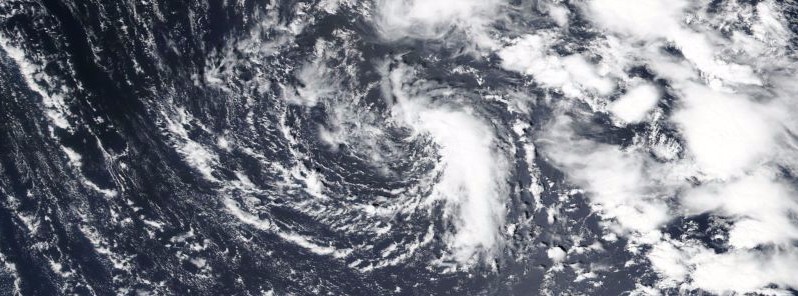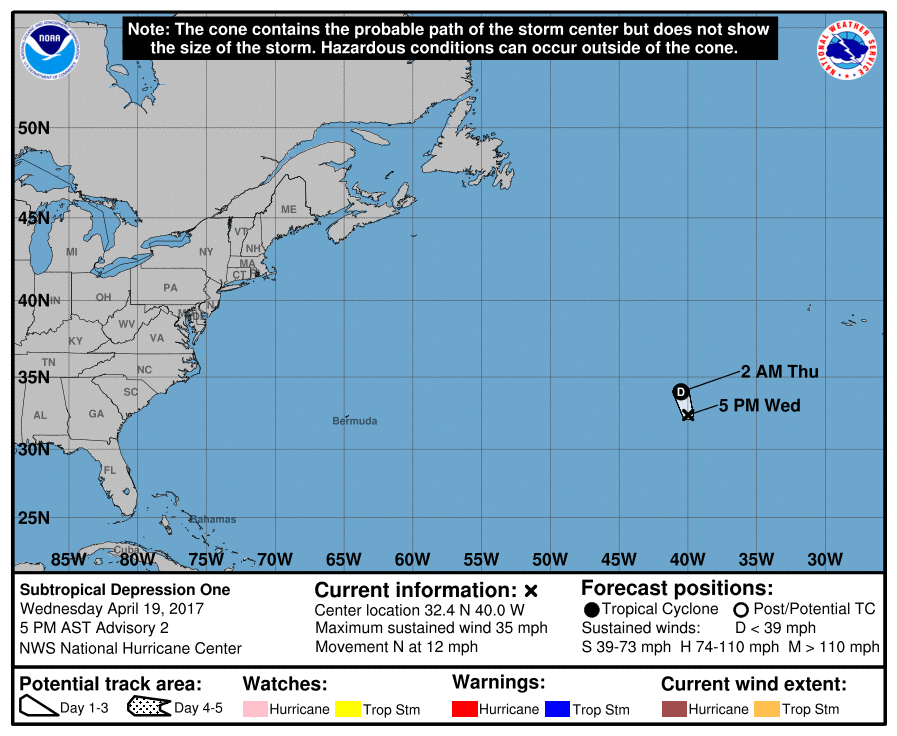Very rare, first subtropical depression of the 2017 season forms in Atlantic

An unusually early subtropical depression, the first of the 2017 Atlantic hurricane season, has formed in the central Atlantic between Bermuda and the Azores on Wednesday, April 19, 2017. The system could soon become Subtropical Storm "Arlene," but this will be a short-lived system without any impact on land. Tropical storm formation this early in a year is very rare, but a there has been a recently noticed trend in early starts to the Atlantic hurricane season.
At 15:00 UTC on April 19, the center of Subtropical Depression One was located about 1 435 km (890 miles) WSW of the Azores. Its maximum sustained winds were 55 km/h (35 mph) and the system was moving NNE at 13 km/h (8 mph). Its minimum estimated central pressure was 995 hPa.

A gradual turn to the north is expected tonight and there is a slight chance system might soon strengthen into a Subtropical Storm "Arlene" before it gets absorbed by a large extratropical low on Thursday.
Tropical storm formation over the Atlantic basin is very rare during the first four months of a year. On April 20, 2003, a subtropical storm named Ana formed and soon gained full tropical characteristics. That made Ana the only tropical storm on record to form in the Atlantic Basin in April, The Weather Channel explained.
"While Ana remains the only April Atlantic tropical storm in records dating to 1851, an April 1992 subtropical storm was found in post-analysis by the NHC. Since it was not classified as such at the time, a later hurricane that year, Andrew, got the "A" name. There have been numerous seasons that started early. On a long-term average, a tropical system forms prior to June about once every 10 years, and these storms tend to be relatively weak, due in part to cooler sea-surface temperatures."
However, there has been a recent trend in early starts to the Atlantic hurricane season, with 2012, 2015 and 2016 all reporting tropical cyclone formation before June 1, the official start of the season.
You might remember a record-breaking Hurricane "Alex" which developed on January 14, 2016. The occurrence of that system was very unusual, as only four known storms have formed in January since the records began in 1851. Alex is the strongest January hurricane in history.
Another unusual event happened during the last year's season when Tropical Storm "Bonnie" formed on May 28 and made landfall near Charleston, South Carolina on May 29, bringing torrential downpours and flooding threats across a major part of the state. Bonnie was the second named storm of the 2016 Atlantic hurricane season.
What is a subtropical storm
According to NHC, a subtropical storm is a non-frontal low-pressure system that has characteristics of both tropical and extratropical cyclones. Like tropical cyclones, they are non-frontal, synoptic-scale cyclones that originate over tropical or subtropical waters, and have a closed surface wind circulation about a well-defined center. In addition, they have organized moderate to deep convection, but lack a central dense overcast.
Unlike tropical cyclones, subtropical cyclones derive a significant proportion of their energy from baroclinic sources, and are generally cold-core in the upper troposphere, often being associated with an upper-level low or trough. In comparison to tropical cyclones, these systems generally have a radius of maximum winds occurring relatively far from the center (usually greater than 60 nautical miles), and generally have a less symmetric wind field and distribution of convection.
Featured image: Subtropical Depression One – April 19, 2017. Credit: NASA/NOAA/DoD Suomi NPP/VIIRS

Commenting rules and guidelines
We value the thoughts and opinions of our readers and welcome healthy discussions on our website. In order to maintain a respectful and positive community, we ask that all commenters follow these rules:
We reserve the right to remove any comments that violate these rules. By commenting on our website, you agree to abide by these guidelines. Thank you for helping to create a positive and welcoming environment for all.